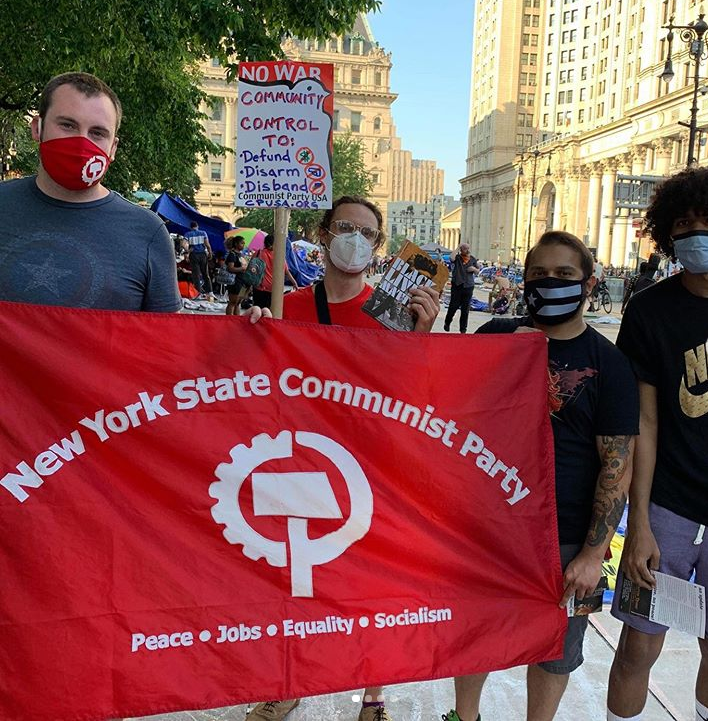
Calendar || Current Areas of Struggle || Articles and Reports
NY CP State Committee - ALU Organizing Report, May 2022
This Report was written by Justine Medina to be presented to the New York State Committee on May 21, 2022.
Greetings, comrades. I was asked to give a brief report on how Party Strategy and Tactics relates to my own work within Amazon Labor Union and the Amazon Labor Union work in general, how ALU is structured, and how that conditions my union work, particularly thinking through how building a new, independent trade union allows for and requires different decisions than working within an existing union.
Unfortunately, I am not able to make the State Committee meeting today myself. I am scheduled to work, and as you may have read in the news, Amazon management has been ramping up firings across the country. As an organizer, it is very important I am on my best behavior and do not do anything that risks getting a write-up or losing my job, so I cannot take the time to step away from my station during unscheduled breaks. However, I have passed along remarks to be read by a comrade, and I hope this report is helpful even though I am not able to participate in discussion or answer questions.
To the question of how Communist Party tactics have been applied to ALU work. As has been written and discussed elsewhere, the ALU’s victories so far have been greatly inspired by application of the history of building the unions in the 30s, which meant interacting with a studying Party history. Some of us on the Organizing Committee even read and drew from the writings of William Z Foster, including Organizing Methods in the Steel Industry.
From these lessons, we have drawn an emphasis on rank-and-file worker-led democracy. The ALU is run almost entirely by current employees at Amazon, and the rest of the leaders are former employees. At JFK8, where we had the election victory, we have recruited an Organizing Committee of roughly 20 people that pulls from every department, every shift, and across every demographic of the warehouse -- across ideology, age, gender, race, and nationality. We made special emphasis to have black and brown, immigrant, and women leaders. At LDJ5, where we lost, we have not quite been as successful at hitting every shift and department, but are still working to build the organizing committee in similar ways.
After the elections, we have continued to focus on this method of training workers to be organizers. We have had organizer trainings with 20 new workers who are interested in joining the Organizing Committee and are currently taking on assignments to have one-on-ones with their coworkers, take shifts handing out flyers or food at weekly union lunches, collect petition signatures for our current “Recognize ALU” campaign, and to recruit still other workers to come to future organizer trainings. We are building up our capacity overtime for militancy and shop floor actions.
At the same time, we have been working to tighten up our own internal structures post-elections, and have brought on more pro-bono lawyers, accountants, and experts to help with crossing the t’s and dotting the i’s. We need strong structures not just for external facing work, but also internally. While previously there were weekly meetings and elections for officers, the ALU structure had been fairly loose, without much regard for designated roles or chain of command. However, we now feel it is incredibly important to tighten up these policies as we transition into an official, legal organization. This transition has led to some internal tensions that we are navigating as a collective, but they are being worked through and will make the ALU stronger in the end. We are developing a code-of-conduct that we are agreeing to in order to be on the Organizing Committee, which includes policies around messaging discipline in regards to social media and to the press, running union decisions through the Executive Board, meeting attendance, among other things.
We are also continuing to develop our strategy relating to other unions as well as grassroots community organizations. ALU plans to continue to develop these relationships, and have been meeting with leaders in the AFL-CIO, the Teamsters, and CWA to think about how we can best collaborate to beat the giant that is Amazon. We have been meeting with politicians and working to help develop legislation to help warehouse workers be safer. We have continued to build relationships with grassroots and community groups, building up the official ALU coalition, which the Party is a part of. It will take all of us, as well as all tactics to win victories for Amazon workers, including the contract at JFK8.
Additionally, we plan to have a national call in July to help workers at Amazon warehouses across the country who are interested in organizing under ALU launch their own union efforts. For now, we are advising these workers to have one-on-ones and build their own solid base for an organizing committee, and passing along resources on having these conversations.
Through all of this work, we will continue to emphasize rank-and-file worker-led movement, and figure out how to have bottom-up democracy while solidifying our own structures for top leadership. It is truly a dialectical process, and we draw and will continue to draw many lessons from the democratic-centralist style model while interfacing with broad coalitions following the lead of the workers.
Onward to victory!





